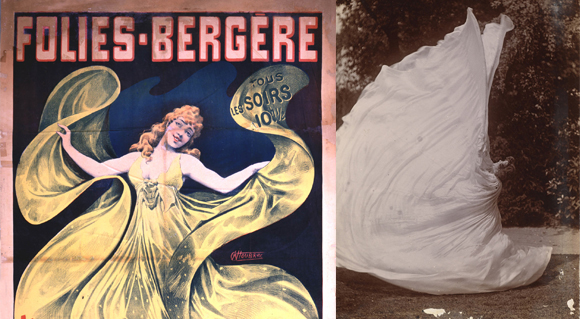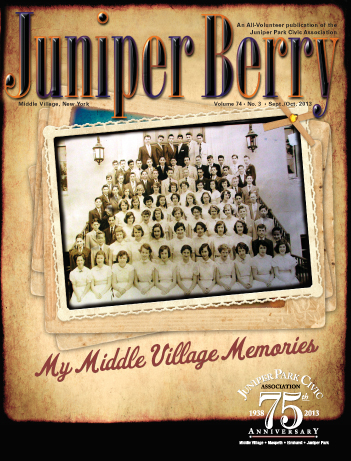The stage is black. Suddenly, yards of illuminated silk emerge out of the darkness and begin to twirl. The vibrant colored lights that shine on the fabric change their shade in coordination with the music. Through the convergence of fabric and light, images of butterflies and flowers are created. The life story of a burning flame is told. There is a dancer beneath the massive amounts of illuminated fabric who works tirelessly, manipulating her body in order to create the magnificent visual effects that are effortlessly portrayed to the audience. This is a brief description of Loie Fuller’s groundbreaking work.
THE HAPPY ACCIDENT
In her autobiography, Loie Fuller describes herself as a “happy accident” who unintentionally stumbled upon her magnificent creative journey. In the late nineteenth century, Fuller was enjoying a successful career as an actress and excelled in the art of skirt dancing- a popular art form of the time. In one of her acting roles, Fuller was required to flutter around a stage that was illuminated with green light. To avoid tripping, Fuller held up her robe with both hands as she danced freely around the stage. The audience instantly reacted as they observed the images that had accidently occurred when the green light lit up Fuller’s robe. “It’s a butterfly!” Someone else shouted, “No, it’s an orchid!” This was the turning point in Fuller’s career as the visual connections the audience made in that moment became the inspiration for her future work with silk and light.
In Fuller’s first solo piece, Serpentine Dance, she manipulated her silk skirt to create shapes that resembled flowers, birds, butterflies, and clouds. Initially, only a gas jet was used to illuminate her silk drapery, however, performing in larger, well- equipped venues rapidly improved her lighting technique. Although Serpentine Dance proved to be successful in America, it wouldn’t be long before Loie Fuller would go on tour in Paris. Here her creativity would be embraced with open arms. This is the place where Fuller’s career would shine and she would become known as the goddess of light.
ART AND SCIENCE COLLIDE
To say that Loie Fuller upgraded the art of skirt dancing would be an enormous understatement. In fact she took her vision to unprecedented heights. In order to create her brilliant stage extravaganzas a number of adjustments had to be made to her costume and lighting. First she eliminated the waistline from her skirt, and instead, hung it from her neck. Next, she added a tremendous amount of silk to her costume. It is estimated that she used approximately 500 yards of material for her piece entitled, Lily Dance. The increased amount of fabric provided a bigger screen for her lights. It also enabled her to form-sized patterns and shapes that filled the stage both horizontally and vertically.
In addition to adding more drapery, Fuller designed wands made of bamboo and aluminum that she connected underneath her silk fabric. These wands (which were curved at the ends) were used as an extension of the arms. They created versatility for many of Fuller’s works by enabling her to execute waving motions as well as statuesque poses. In addition, various styles of wings were constructed through the use of wands. These wands also created folds in the silk draperies, which were used for wide-ranging effects.
Loie Fuller’s biggest scientific accomplishment was her groundbreaking use of light. In Fire Dance, one of her most famous works, Fuller performed on a large piece of glass, which was inserted into a trap door on stage level as colored lights illuminated her from beneath. This process, which she termed “underlighting,” was one of Fuller’s most outstanding inventions. This special lighting technique made her appear as if she were suspended in air as she performed. In order to create the complex effects of underlighting, Fuller had an enormous stage crew, usually consisting of more than sixty electricians who were responsible for changing the numerous colored gelatins underneath the stage. Fuller thoughtfully choreographed her movements as well as her lighting, so it was mandatory for the electricians to have precise timing. The combination of the resources required to create a complete Loie Fuller production was so complex that she had her inventions patented.
FULLER’S INFLUENCE
After spending fifteen years as a famous dancer, Loie Fuller opened a dance school in France where she taught the art of “natural dancing.” Her school and touring company consisted of young girls aged five to twenty-nine who learned mesmerizing group dances that were inspired by Fuller’s early solo work. It was during this time that she also made new creative discoveries such as shadow dances. In these new dances, company members were placed behind a huge screen. Depending on their distance from the light, the size of their shadows ranged from tiny to gigantic. Dancers in view of the audience would often interact with these shadow images. For the fascinated viewer, it was difficult to decipher whether they were watching one dancer and their shadow, two separate dancers, or a dancer and another dancer’s shadow.
A century later, similar shadow dances continue to be performed on some of the most famous stages in the world. To understand the effects light can have on the size projection of a shadow, one may look at the style in which Michael Jackson performed Smooth Criminal in concert. Jackson’s shadow is projected much larger than the two others who appear to dance directly beside him. Live dancers also continue to interplay with the shadows of others who are projected on screen behind them. In recent years, the Broadway show Young Frankenstein, used this same technique that Loie Fuller was experimenting with over a century ago. It seems that Loie Fuller’s innovations have profoundly influenced modern day performers, although she is rarely credited for her contributions.
Throughout her career, Loie Fuller was plagued by countless imitators and this continues to be a problem when one researches her work. Unfortunately, searching videos on the internet only produces results of her many imposters. Due to the lack of video recordings available, it is extremely difficult for a researcher to grasp the full power of her work. Those interested in Fuller rely heavily on descriptive writings, sketches, drawings, and present day dance companies who perform Loie Fuller tributes in order to gain insight into her magical world of silk and light.




